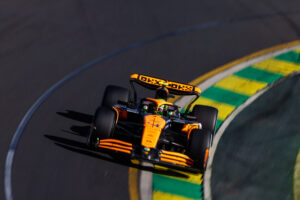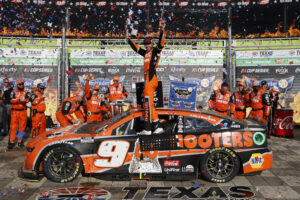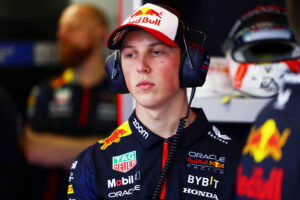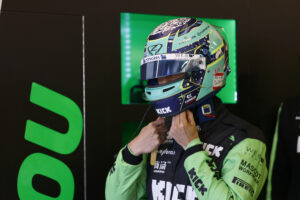Alex Andrejev sits in the media center at Daytona International Speedway and waits for news on Ryan Newman’s condition.
An ambulance transported him to Halifax Medical Center, after his wreck on the final lap of the Daytona 500.
The atmosphere in the room is tense. Veteran reporters tell her they flashbacked to Dale Earnhardt’s fatal wreck on the final lap of the 2001 Daytona 500.
“There really was a very intense couple-hour period where everyone was sort of on edge and just trying to wait for an update,” she said. “But also be patient, and know that something was going to come eventually, but just not really knowing what that timeline was going to be like, if we were going to have to be there all night, if it was going to be just a few short minutes, and then no one knew, really, what the diagnosis was going to be. It was scary.”
She and some other reporters contemplate going over to the hospital to get more information. While some do, she remains in the deadline room.
“Everyone’s just trying to get as much information as possible,” she said. “But essentially, it was just like this waiting game.”
Finally, NASCAR announced that Newman’s condition was stable and his injuries were non-life threatening.
For Andrejev, it’s one hell of a kickoff to her first year as a NASCAR beat writer.
The beginning
A graduate of Columbia University and the University of Southern California, she worked six months as a sports intern for The Washington Post. As it was “kind of a general assignment sports reporting internship,” she covered teams such as the Nationals, the Mystics, the Spirit, etc. Moreover, she covered high school sports in the D.C. area and wrote features on the 2019 FIFA Women’s World Cup.
In December, she saw an opening at The Charlotte Observer for a NASCAR beat writer. So she asked Liz Clarke, a longtime sportswriter who previously covered NASCAR, whether or not she should apply for it.
“She was like, ‘Oh, you should definitely apply,’ and that’s sort of how I got my start,” Andrejev said.
Furthermore, her Esports coverage piqued the interest of Matt Stephens, senior sports editor for McClatchy Southeast and “pretty big video game nerd.”
“After talking to her, she went into covering Esports, having really little to no video game knowledge,” he said. “And then, what that showed me was she could learn something new and learn it well quickly and be able to talk like she knew what she was talking about. She was able to learn.”
NASCAR put her ability to learn to the test.
Welcome to NASCAR
While not a complete stranger to NASCAR, she faced a steep learning curve with learning both the basics and the inner machinations of the league, brushing up on every team in the garage, getting to Charlotte, North Carolina, to introduce herself to people on both the team side and NASCAR side of operations.
“It was just to try to meet as many people as quickly as possible,” she said. “Make sure you’re going into the garages and introducing yourself, and talking to people at the Daytona 500, and just setting up these calls and stuff, and really trying to show your face to people and let them know that, ‘Hey, I’m going to be around.’”
And Andrejev was around, starting with Daytona 500 media day.

At first, she stood aside the media scrum that surrounded Roush Fenway Racing drivers Chris Buescher and Newman, then asked her questions. She started with Buescher, because “he looked a little bit less intimidating than Ryan.”
“I kind of was like, ‘Oh, man,’” she said. “‘I’m a little bit nervous, and I don’t really know how to talk to these guys first. I hope they don’t think my questions are dumb.’”
Buescher and Newman put her at ease, as they answered her questions, professionally, and were friendly to her.
Learning from the pros
Moreover, members of the traveling beat reached out and showed Andrejev the ropes. Sometimes, it was writers DMing her on Twitter to answer a question she tweeted. Other times, it was showing and telling her the do’s and don’ts of the trade.
“Kelly Crandall, she was probably one of the first that walked me around (Daytona) and gave me a full tour of everything,” Andrejev said, “and sort of told me, ‘OK. Do this. Don’t do this,’ and, ‘This is what some people will tell you, but here’s what you should do,’ and was helping me make introductions and stuff.”
The level of help she received from fellow writers surprised her.
“I think in a lot of beats in sports I had covered before, it feels like there’s this very intense competitive energy,” she said. “Which that’s not to say that there isn’t that, necessarily, in NASCAR coverage, but I think I was surprised in how much people were willing to help out a rookie.”
Back home
After the whirlwind of the Daytona 500, Andrejev stayed back in Charlotte to watch NASCAR’s West Coast Swing. Her next race was March 15, at Atlanta Motor Speedway.
Or so she thought.
COVID outbreak
On March 11, Utah Jazz center Rudy Gobert tested positive for COVID-19, the first NBA player to contract it. Over the next few hours, the sports world ground to a halt on a level not seen since the 9/11 attacks.
NASCAR, however, planned to race on, that weekend. Just without fans in attendance.
While all this went down, Andrejev drove to her sister’s house in Atlanta.
“It was sort of that expectation, that was after other professional sports leagues had shut down,” she said. “So there was sort of this expectation of, all right, are they actually going to run this race?”
She was skeptical, but drove to the track, anyway.
On the way, she received the word.
— NASCAR (@NASCAR) March 13, 2020
Over the next few months, with no sports happening, outlets furloughed or out-right released writers. Job security became a concern for many, including Andrejev.
“I think there was just a lot of questions, and no one really knew,” she said. “You’d go, and they were like, ‘Well, we have to see.’”
Fortunately, she fared better than others, as she pivoted to covering NASCAR’s iRacing Pro Invitational Series, as well as pitching in on covering COVID.
Back to racing

Eventually, NASCAR returned to action May 17, at Darlington Raceway. A week and two races later, NASCAR returned to Charlotte Motor Speedway to run one of its crown jewel races, the Coca-Cola 600.
Andrejev covered her first race since Daytona, on May 24.
Fellow writers warned her that it’s a long race. While she was excited to be back at the race track, the marathon nature of the Coke 600 took its toll on her.
“I remember that was kind of the first thing I thought was just, ‘Oh, my gosh. My ears hurt so badly from wearing the mask for this long.’ And it just keeps going and going, and we’re stopping, and it’s delayed (due to rain),” she said.
She didn’t get back home until 2 a.m.
But that’s not where the story ends.
Down with the sickness?
Finished with her Coke 600 stories, she hops in her car and cranks the engine. She takes a deep breath and realizes she has the sniffles.
It was a new development, as she went into the press box that morning without a runny nose. She chalked it up to allergies.
Andrejev forgot about it, until she received a text from NASCAR the next day to fill out the health screening questionnaire that all writers are required to do for every race before they can enter the press box.
One of the questions asks if you’re currently experiencing a runny nose, which is a symptom of COVID-19.
“It was so early on too that you are very worried,” she said. “I’m like, ‘Oh, my gosh. I am showing one symptom. Do I have it?’ Something like that.
“I was sort of being proactive, and I put that I had had a runny nose before.”
Later, she received a call from Ryan Stanton, medical director for American Medical Response (NASCAR’s safety team), and they conversed about her symptom. They concluded it was nothing more than allergies.
On Tuesday, May 26, she entered the press box at Charlotte and covered the NASCAR Gander RV & Outdoors Truck Series race with no issues.
Other beats for the Observer
Now in addition to NASCAR, Andrejev covers soccer for the Observer. But aside from a Charlotte FC U17 game, all there was to cover this year was the building of the Queen City’s new MLS team.
“Yeah. I mean, it’s been pretty slow with news on that beat, honestly, because of COVID, and everything’s getting pushed back now,” she said.
Likewise, she pitches in to cover more serious matters, like protests.
Protests
The death of George Floyd sparked nationwide protests this summer, and Charlotte was no exception. The Observer pulled reporters from just about every beat that had spare time to cover the nightly protests that lasted for weeks, as well as relieve the general reporters.
“I think it was three nights that I was out on the ground, and it really is just walking for hours on end and charting,” she said. “You’re watching the police, you’re watching the protestors, and sort of doing live tweets that I was really doing, and then we had kind of an editor and another reporting compiling all of these live tweets.”
During the day, she kept tabs on NASCAR news. Then at night, she walked around Charlotte for hours, covering the protests.
“Yeah. It was an intense couple weeks there,” she said.
Pro-tips
As the NASCAR season progressed, Andrejev picked up pro-tips, such as buy a mask that ties, TSA PreCheck is worth the price for traveling writers and “don’t be afraid to ask what you think might be a stupid question.”
“That was definitely something I was kind of nervous about at first,” she said. “But I feel like if you’re wondering it, someone else probably is too. So it’s worth asking.”
Furthermore, she learned to be prepared to sit in the press box for hours, during a rain delay.
Or even days.
Rain delay at Texas

NASCAR red-flagged the Cup Series race at Texas Motor Speedway after 51 laps, on October 25, because of mist.
“I mean, it was kind of surprising because the weather forecast, all the weather forecasters said it’s going to be sunny,” she said, “and the clouds will clear, and everyone’s telling me in the morning… It was definitely overcast in the morning, but everyone’s like, ‘Oh, it’s just Texas weather, and it’ll blow right through.’”
It lasted for three days.
She didn’t stay for all three, however. She flew back to Charlotte on October 27. Though her traveling beat writer co-hort and Texas resident, Jerry Jordan, remained for all three.
While on-site at Texas, Andrejev’s live updates story about a red-flagged race was the most viewed story across all of McClatchy (the Observer’s parent company), on October 25.
“I was like, oh, man,” she said. “I try to do all this hard-hitting journalism. Here’s my rain delay story for a race that’s not even happening, yet. It’s getting the most page views.”
“Hard-hitting” stories include a bullied paint scheme graphics designer.
Noah Sweet
Pinned to Andrejev’s Twitter profile is a story about Noah Sweet, who was bullied and harassed for making a paint scheme that celebrates LGBTQ+ pride.
She pursued the story, because “there was such an important message in it.”
“I was sort of not surprised, I guess, that no one else had done it, really,” she said. “But I feel like it was sort of this undercurrent of NASCAR, that people had seen it and didn’t really know what it was. So I think to be able to talk to him, to talk to his mom, and try to bring that to light was something that was really cool, and sort of provide more clarity on what actually had happened in that situation.
“It felt kind of important.”
The checkered flag flies

The checkered flag flies at Phoenix Raceway. Chase Elliott celebrates his first Cup Series championship with a can of Bud Light in his hand. Everyone files their race and championship stories, then either head back to their hotels for the night or red-eye back to the East Coast.
Andrejev completes her first season as a NASCAR beat writer, in arguably the oddest year ever.
“Everyone kept saying to me all season, ‘Oh, what a quiet little beat you landed on,’ jokingly,” she said. “But it’s like you want to be covering stuff that people are reading and people care about, and sports was certainly changing over the course of this year, and trying different things, and goes through these major policy changes with the (Confederate) flag ban, and you have Michael Jordan coming in.
“This was just such a cool time to be covering NASCAR.”
And she’s grateful for the opportunity.
TOP IMAGE: Alex Andrejev






